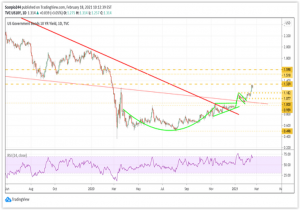Allow me to present one chart to you that could indeed prove to be a game changer for investors and financial markets going forward. See below.

What are we looking at in the chart above? It is the 10-Year Treasury bond interest rate going back to June 1, 2019.
In the world of technical analysis, this chart shows an almost perfect bottoming out pattern. The rate on these bonds rose up to 1.61% intraday in recent trading days, versus 0.49% recorded back in August 2020, a massive 110 basis point move up for the usually quiet world of fixed income.
Why could this be a game changer? If it continues along the path it has been going for the past six months, it can have profound effects on the equity markets, fixed income markets, investors’ behavior, and companies’ behavior.
In one example here, I point out that large high-tech stocks are predominantly high duration securities, with projected cash flows far out in the future. Hence, they are very sensitive in a negative way to interest rate increases.
Those very large gains that we enjoyed for this sector last year could evaporate pretty quickly if rates continue their march upwards. These particular stocks could get steadily revalued downward as a result of higher rates.
Within the equity markets, what sectors could prosper, at least in a relative sense? Financials, energy, raw materials, real estate all come to mind.
These are the groups that many in the the financial media are labeling as “reflationary” stocks. The market has actually already started factoring some of this in already. Just look at the outperformance of these reflationary equity groups year-to-date versus the S&P 500.
Tailwinds
On a grander scale, however, the overall stock market could at some point be at risk if interest rates keep marching upwards. Recall the classical dividend discount model and what is in that formula’s denominator. It’s interest rates.
So, a rise in interest rates reduces the fair value of the market arithmetically, all other variables being held constant.
Maybe more intuitively, as rates move up, bonds become a more competing and compelling alternative to stocks. The aura of TINA (“there is no alternative”) as it pertains to the stock market starts to diminish.
Lastly, how about all of that cash sitting in investors’ bank accounts that we have read about in recent months? In an ultra-low interest rate environment, it is desperately looking for another place to be, like the stock market.
As rates increase, however, this driving force is not as strong. Investors may be content to let those funds remain in their money market account if they start to earn some respectable interest on their balance.
So that particular tailwind for stocks, which was in place for much of last year, could come to a screeching halt.
You get the picture. The chart I show above could very much be a game changer for many investors spanning multiple financial markets. We just have to sit back and see if the upward move in interest rates continues to unfold like it has since August of last year.


